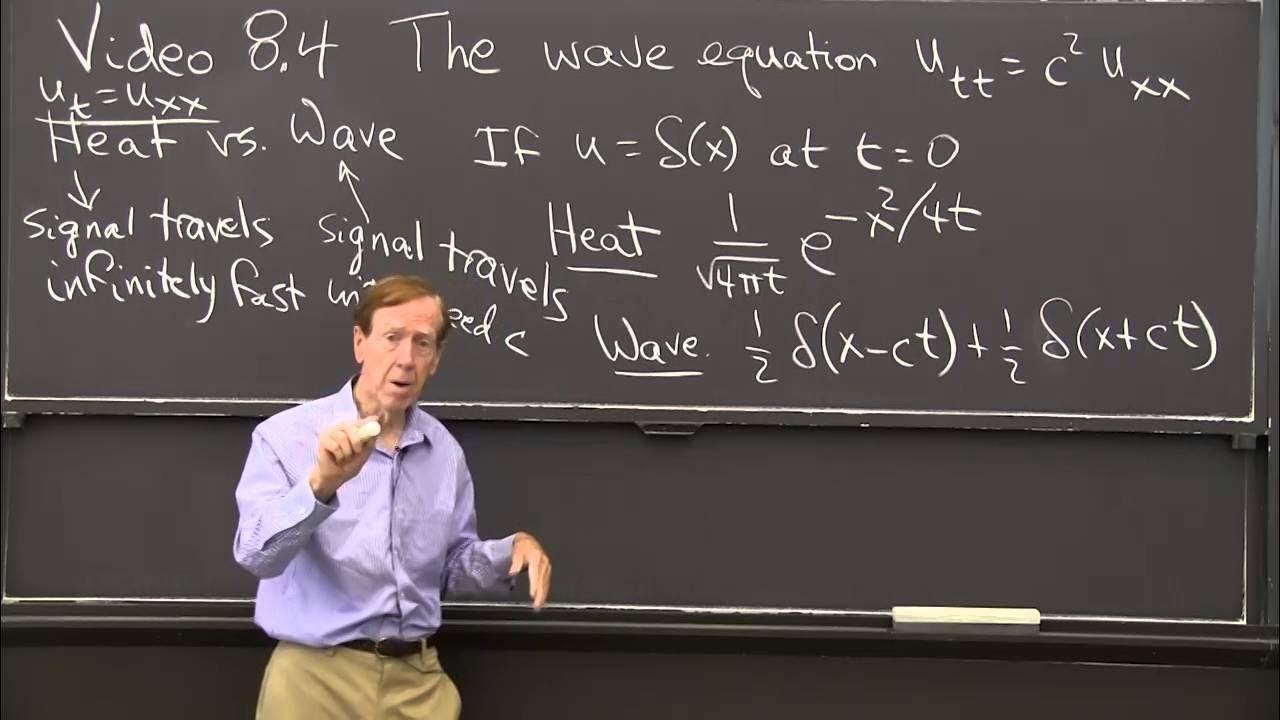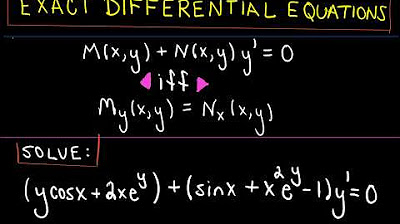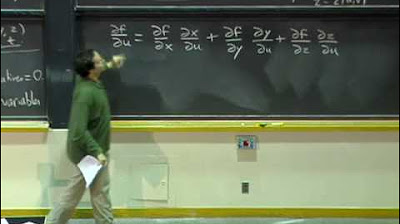But what is a partial differential equation? | DE2
TLDRThe video script delves into the concept of partial differential equations (PDEs), using the heat equation as a central example. It begins by illustrating how heat distributes across an object over time, leading to the formulation of the heat equation. The script then explains the transition from ordinary derivatives to partial derivatives, emphasizing the multidimensional nature of the problem. The heat equation is derived from a discrete model, where the temperature change at a point is proportional to the second difference of its neighbors' temperatures. This concept is then generalized to the continuous case, where the second derivative with respect to space is used. The script also touches on the broader applications of the heat equation in various fields such as Brownian motion and finance. It concludes with a teaser about Fourier series, which is closely related to the heat equation, and a recommendation for a book by Steve Strogatz that provides an accessible and engaging introduction to calculus and its applications.
Takeaways
- 🔥 The heat equation is a partial differential equation (PDE) that models how heat is distributed over time in an object, such as a metal rod.
- 🌡️ The temperature distribution across an object changes over time as heat flows from warmer to cooler areas, which can be visualized through color representations and graphs.
- 📐 In one-dimensional examples, such as two rods at different temperatures, heat flows from the hotter rod to the cooler one, aiming to equalize the temperature over time.
- 🎓 Differential equations are used to describe the change in temperature moment by moment, which is easier than describing the full evolution of the system.
- 📉 The heat equation is written using partial derivatives, which consider multiple dimensions in the input space, such as space and time.
- 🌟 Fourier series, a mathematical tool for representing functions as an infinite sum of sinusoids, was developed by Joseph Fourier to solve the heat equation.
- 🔩 The heat equation and its variations are fundamental in various fields, including Brownian motion, finance through the Black-Scholes equations, and diffusion processes.
- 📈 The rate of change for a point's temperature is proportional to the second difference around it, which in the continuous case is represented by the second derivative.
- 🧮 The Laplacian, often denoted by the upside-down triangle symbol (∇^2), is used in higher dimensions to represent the sum of all second spatial derivatives, measuring how different a point is from the average of its neighbors.
- 📚 Steve Strogatz's book 'Infinite Powers' is recommended for those interested in calculus and its real-world applications, with a focus on constructing solutions to complex problems from simple building blocks.
- 🎨 The math behind Fourier series, which can approximate any curve by adjusting the initial size and angle of rotating vectors, is the same as the math describing the physics of heat flow.
Q & A
What is the heat equation?
-The heat equation is a partial differential equation that describes how the distribution of heat changes over time within a given region, such as a metal rod. It models how heat flows from warmer areas to cooler ones, leading to a more uniform temperature distribution.
How does the heat equation relate to Fourier series?
-The heat equation is historically significant because it was the physical problem that Joseph Fourier was trying to solve when he developed what is now known as the Fourier series. This mathematical tool is used to represent functions as an infinite sum of sines and cosines, which has wide applications in various fields.
What is a partial derivative?
-A partial derivative is a derivative that deals with functions of multiple variables by differentiating with respect to one variable while keeping the other variables constant. It describes the rate of change of a function with respect to one of its variables.
Why are partial differential equations (PDEs) generally harder to solve than ordinary differential equations (ODEs)?
-PDEs are generally harder to solve than ODEs because they involve an infinite number of values changing together, as opposed to ODEs which typically deal with a small number of variables changing over time. PDEs also often require more complex mathematical techniques to solve.
What is the significance of the second derivative in the heat equation?
-The second derivative in the heat equation, often with respect to spatial variables, indicates how the rate of change of the temperature is itself changing. It is a measure of how a point's temperature compares to the average temperature of its neighbors, which is crucial for understanding how heat distributes over time.
How does the heat equation apply to a one-dimensional rod?
-In the one-dimensional case of a rod, the heat equation describes how the temperature varies along the length of the rod over time. It considers the rate at which heat changes at each point on the rod and how this change is influenced by the temperatures at neighboring points.
What is the concept of 'second difference' in the context of the heat equation?
-The 'second difference' is a term used to describe the difference between the differences in temperature values at neighboring points. It is a discrete approximation of the second derivative used in the heat equation to model how the temperature at a point changes over time based on the temperatures of its immediate neighbors.
What is the Laplacian operator in the context of multi-dimensional heat equations?
-The Laplacian operator, often denoted by the symbol '∇^2', is a differential operator that represents the sum of all second-order partial derivatives in a multi-dimensional space. It measures how a function deviates from being a harmonic function, and in the context of the heat equation, it helps to describe how a point's temperature differs from the average of its neighbors in multiple dimensions.
How does the heat equation model the physical phenomenon of heat conduction?
-The heat equation models heat conduction by expressing the rate of change of temperature at any point as proportional to the second derivative of the temperature with respect to space. This means that the temperature at a point tends to change towards the average temperature of its neighboring points, leading to a smoothing effect over time.
What is the role of the proportionality constant, often denoted by 'α', in the heat equation?
-The proportionality constant 'α' in the heat equation quantifies the rate at which heat conduction occurs. It is a material-specific property that determines how quickly heat diffuses through a substance, affecting the speed at which temperature equalizes across the object.
Why is the heat equation considered fundamental in various scientific fields?
-The heat equation is fundamental because it describes a basic physical process—diffusion of heat—that is applicable in many scientific fields, including physics, engineering, biology, and finance. Variations of the heat equation appear in models of Brownian motion, the Black-Scholes equations in finance, and various other diffusion processes, making it a versatile tool for mathematical modeling.
How does the concept of a Fourier series help in solving the heat equation?
-A Fourier series allows us to represent a function as an infinite sum of sinusoidal functions, which are eigenfunctions of the Laplacian operator. This representation simplifies the process of solving the heat equation, as it converts the problem into a series of simpler ordinary differential equations that can be solved individually.
Outlines
🔥 Introduction to the Heat Equation
The first paragraph introduces the concept of the heat equation, a type of partial differential equation (PDE), which is used to describe how heat is distributed over an object like a metal plate and how this distribution changes over time. The paragraph explains that while ordinary differential equations (ODEs) deal with changes over time for a few variables, PDEs model how infinitely many values change simultaneously. The heat equation is particularly interesting because it has applications in various fields, including Brownian motion and finance. The paragraph also hints at the Fourier series, which is deeply connected to the heat equation, and describes an animation that illustrates how rotating vectors can be used to approximate any shape, which is related to the physics of heat flow.
🌡️ Understanding Partial Derivatives in the Heat Equation
The second paragraph delves into the mathematical details of the heat equation, focusing on partial derivatives. It explains that the temperature function has multiple dimensions (space and time), leading to different rates of change, which are represented by partial derivatives. The notation for partial derivatives is introduced, using a special symbol called del. The heat equation is described as relating the rate of change of temperature over time to the second partial derivative with respect to space. The paragraph also discusses the intuition behind the heat equation, suggesting that points on a temperature curve tend to change more quickly in the direction of the curve's curvature. It concludes by explaining how the heat equation can be derived from a discrete version of the problem, where the temperature values are finite and the rate of change at a point is proportional to the difference between its neighbors and its own value.
📐 Transitioning from Discrete to Continuous: Second Derivatives
The third paragraph continues the exploration of the heat equation by transitioning from the discrete model to the continuous one. It discusses how the concept of a second difference in the discrete model corresponds to the second derivative in the continuous case. The paragraph emphasizes the idea that the rate of change of temperature at a point is proportional to the second derivative, which measures how a point differs from the average of its neighbors. The second partial derivative is introduced as a way to express this concept mathematically, and the paragraph provides an intuition for how this derivative works, relating it to the curvature of the temperature graph. It also touches on the generalization of this concept to multiple dimensions using the Laplacian operator.
📚 Solving PDEs and the Impact of Fourier
The final paragraph encourages a sense of accomplishment for understanding partial differential equations (PDEs) and hints at the satisfaction of solving them. It mentions the historical context of Jean-Baptiste Joseph Fourier, who developed methods to solve the heat equation, and teases the upcoming discussion on his work. The paragraph also includes a personal note from the author, mentioning Steve Strogatz's book 'Infinite Powers' and its influence on the topic's coverage. The author expresses a desire to share the joy of math and calculus with a broader audience, highlighting the book's effectiveness in making complex ideas accessible and engaging. The paragraph concludes with a recommendation for the book as a resource for both those new to math and those who already appreciate the subject.
Mindmap
Keywords
💡Partial Differential Equation (PDE)
💡Heat Equation
💡Fourier Series
💡Second Derivative
💡Laplacian
💡Ordinary Differential Equation (ODE)
💡Discrete vs. Continuous
💡Proportionality Constant
💡Second Difference
💡Gradient
💡Divergence
Highlights
Introduction to the heat equation, a partial differential equation (PDE) that models how heat is distributed over time across an object like a metal plate.
The heat equation is used to describe how the temperature distribution changes over time as heat flows from warmer to cooler spots.
The heat equation is connected to various areas of math and physics, including Brownian motion, the black-Scholes equations in finance, and diffusion processes.
Fourier series, a mathematical tool for representing periodic functions, was developed by Joseph Fourier to solve the heat equation.
The animation demonstrates how rotating vectors can be used to approximate any curve, which is related to the physics of heat flow.
The heat equation is constructed by considering the temperature as a function of both position and time, leading to the use of partial derivatives.
Partial derivatives describe the rate of change of the temperature function with respect to space and time separately.
The heat equation is written in terms of partial derivatives, showing that the rate of change with respect to time is proportional to the second partial derivative with respect to space.
The heat equation can be derived from a discrete version of the setup, where only a finite set of temperature values is considered.
The rate of change for a point's temperature is proportional to the second difference around it, which is analogous to the second derivative in the continuous case.
The heat equation is a PDE that tells a richer story than ordinary differential equations (ODEs) and is generally harder to solve.
The general heat equation can be applied to bodies in any number of dimensions, but the focus is on the one-dimensional case of a rod for simplicity.
The Laplacian, a mathematical operator, is used in higher dimensions to represent the sum of all second spatial derivatives.
The Laplacian operator measures how different a point is from the average of its neighbors in a multi-dimensional space.
Understanding and solving PDEs, such as the heat equation, provides a powerful tool for describing the world around us.
The video mentions Steve Strogatz's book 'Infinite Powers' as a great resource for understanding calculus and its real-world applications.
Transcripts
Browse More Related Video
5.0 / 5 (0 votes)
Thanks for rating:





